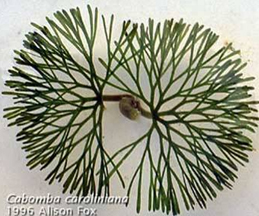
Fanwort, known commonly by its scientific name Cabomba caroliniana, is a non-native aquatic invasive species introduced from South America. This plant is listed as a banned invasive and is listed as a noxious weed in several other U.S. states.
While the most common method of introduction is the dumping of old aquarium plants, Cabomba is also capable of rapidly spreading on its own by stem fragments or rhizomes.
Problems
Cabomba is an extremely competitive and persistent plant capable of forming dense mats that crowd out native plants. Once established, the plant can clog waterways, disrupting fishing and boating.
In cases of severe infestation, Cabomba can raise water levels to the point of overflow.
Plant Description
Fanwort is multi-branched submerged perennial plant except for a few small (1/2 - 1 1/4 inches long) alternately arranged elongated floating leaves. The submerged leaves are opposite, attached by a single petiole, but above the petiole form a finely divided "fan-shaped" leaf. Fanwort has a small (1/2 to 3/4 inch diameter) white to pink flower which arises from the tip of the stem and stands slightly above the water surface.
A subspecies of Cabomba (Purple fanwort - Cabomba pulcherrima) has a purple appearance instead of green.
Hints to Identify
Look for slightly flattened stems that arise from the base of the plant. Cabomba's flowers have three petals that are pink to yellow, and may be spotted. Each flower is approximately 10mm wide.
Common Application Questions
Q. When is the best time to treat?
A. Plants must be present to treat. Water temperatures should exceed sixty degrees Fahrenheit.
Q. How often do I need to treat Cabomba?
A. One to two treatments per season is usually plenty.
Q. How long before I see results?
A. Generally within twelve to sixteen day things will be cleared up.
| Homeowner Treatment Options |
| Sonar AS |
| Sonar RTU |
| *Aquatic Biologists recommends implementing preventative management techniques and physical removal prior to, or in conjunction with treatment. |
